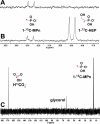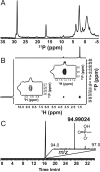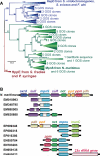Synthesis of methylphosphonic acid by marine microbes: a source for methane in the aerobic ocean
- PMID: 22936780
- PMCID: PMC3466329
- DOI: 10.1126/science.1219875
Synthesis of methylphosphonic acid by marine microbes: a source for methane in the aerobic ocean
Abstract
Relative to the atmosphere, much of the aerobic ocean is supersaturated with methane; however, the source of this important greenhouse gas remains enigmatic. Catabolism of methylphosphonic acid by phosphorus-starved marine microbes, with concomitant release of methane, has been suggested to explain this phenomenon, yet methylphosphonate is not a known natural product, nor has it been detected in natural systems. Further, its synthesis from known natural products would require unknown biochemistry. Here we show that the marine archaeon Nitrosopumilus maritimus encodes a pathway for methylphosphonate biosynthesis and that it produces cell-associated methylphosphonate esters. The abundance of a key gene in this pathway in metagenomic data sets suggests that methylphosphonate biosynthesis is relatively common in marine microbes, providing a plausible explanation for the methane paradox.
Figures



Similar articles
-
Methylphosphonic Acid Biosynthesis and Catabolism in Pelagic Archaea and Bacteria.Methods Enzymol. 2018;605:351-426. doi: 10.1016/bs.mie.2018.01.039. Epub 2018 May 3. Methods Enzymol. 2018. PMID: 29909833 Review.
-
Methane production by phosphate-starved SAR11 chemoheterotrophic marine bacteria.Nat Commun. 2014 Jul 7;5:4346. doi: 10.1038/ncomms5346. Nat Commun. 2014. PMID: 25000228
-
Structural basis for methylphosphonate biosynthesis.Science. 2017 Dec 8;358(6368):1336-1339. doi: 10.1126/science.aao3435. Science. 2017. PMID: 29217579 Free PMC article.
-
Structural insights into light harvesting by antenna-containing rhodopsins in marine Asgard archaea.Nat Microbiol. 2025 Jun;10(6):1484-1500. doi: 10.1038/s41564-025-02016-5. Epub 2025 May 29. Nat Microbiol. 2025. PMID: 40442502 Free PMC article.
-
Expanding anaerobic alkane metabolism in the domain of Archaea.Nat Microbiol. 2019 Apr;4(4):595-602. doi: 10.1038/s41564-019-0364-2. Epub 2019 Mar 4. Nat Microbiol. 2019. PMID: 30833728 Review.
Cited by
-
Transcriptomic Insights into Archaeal Nitrification in the Amundsen Sea Polynya, Antarctica.J Microbiol. 2023 Nov;61(11):967-980. doi: 10.1007/s12275-023-00090-0. Epub 2023 Dec 7. J Microbiol. 2023. PMID: 38062325
-
Genomic and proteomic characterization of "Candidatus Nitrosopelagicus brevis": an ammonia-oxidizing archaeon from the open ocean.Proc Natl Acad Sci U S A. 2015 Jan 27;112(4):1173-8. doi: 10.1073/pnas.1416223112. Epub 2015 Jan 13. Proc Natl Acad Sci U S A. 2015. PMID: 25587132 Free PMC article.
-
Oxic methane production from methylphosphonate in a large oligotrophic lake: limitation by substrate and organic carbon supply.Appl Environ Microbiol. 2023 Dec 21;89(12):e0109723. doi: 10.1128/aem.01097-23. Epub 2023 Nov 30. Appl Environ Microbiol. 2023. PMID: 38032216 Free PMC article.
-
Methylphosphonate Degradation and Salt-Tolerance Genes of Two Novel Halophilic Marivita Metagenome-Assembled Genomes from Unrestored Solar Salterns.Genes (Basel). 2022 Jan 15;13(1):148. doi: 10.3390/genes13010148. Genes (Basel). 2022. PMID: 35052488 Free PMC article.
-
An Unusual Oxidative Rearrangement Catalyzed by a Divergent Member of the 2-Oxoglutarate-Dependent Dioxygenase Superfamily during Biosynthesis of Dehydrofosmidomycin.Angew Chem Int Ed Engl. 2022 Jul 25;61(30):e202206173. doi: 10.1002/anie.202206173. Epub 2022 Jun 7. Angew Chem Int Ed Engl. 2022. PMID: 35588368 Free PMC article.
References
-
- Rogers JE, Whitman WB, editors. Microbial production and consumption of greenhouse gases : methane, nitrogen oxides, and halomethanes. American Society for Microbiology; Washington, D.C.: 1991.
-
- Karl DM, et al. Nat. Geosci. 2008;1:473.
-
- Reeburgh WS. Chem. Rev. 2007;107:486. - PubMed
-
- Daughton CG, Cook AM, Alexander M. FEMS Microbiol. Lett. 1979;5:91.
-
- Martinez A, Tyson GW, DeLong EF. Environ. Microbiol. 2010;12:222. - PubMed
Publication types
MeSH terms
Substances
Grants and funding
LinkOut - more resources
Full Text Sources
Other Literature Sources
Molecular Biology Databases

